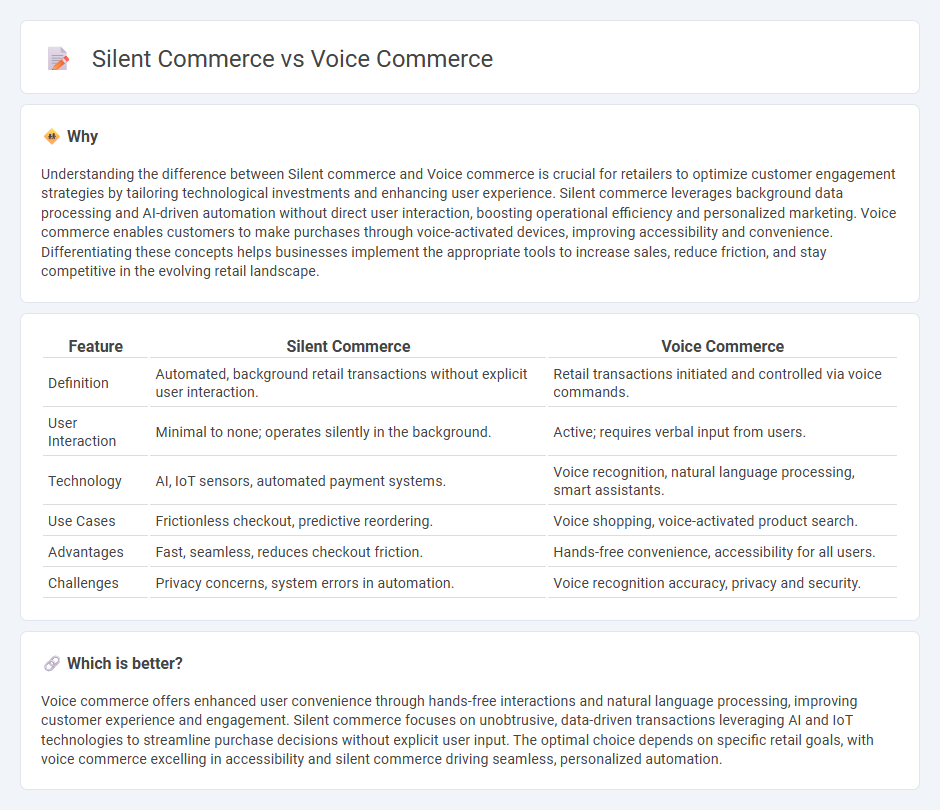
Silent commerce streamlines purchasing by enabling transactions through background technologies such as IoT devices and automated reordering systems, minimizing direct customer interaction. Voice commerce relies on voice-activated assistants like Alexa and Google Assistant to facilitate shopping through spoken commands, enhancing user convenience and accessibility. Explore the distinctions between silent and voice commerce to understand their impact on the future of retail shopping experiences.
Why it is important
Understanding the difference between Silent commerce and Voice commerce is crucial for retailers to optimize customer engagement strategies by tailoring technological investments and enhancing user experience. Silent commerce leverages background data processing and AI-driven automation without direct user interaction, boosting operational efficiency and personalized marketing. Voice commerce enables customers to make purchases through voice-activated devices, improving accessibility and convenience. Differentiating these concepts helps businesses implement the appropriate tools to increase sales, reduce friction, and stay competitive in the evolving retail landscape.
Comparison Table
| Feature | Silent Commerce | Voice Commerce |
|---|---|---|
| Definition | Automated, background retail transactions without explicit user interaction. | Retail transactions initiated and controlled via voice commands. |
| User Interaction | Minimal to none; operates silently in the background. | Active; requires verbal input from users. |
| Technology | AI, IoT sensors, automated payment systems. | Voice recognition, natural language processing, smart assistants. |
| Use Cases | Frictionless checkout, predictive reordering. | Voice shopping, voice-activated product search. |
| Advantages | Fast, seamless, reduces checkout friction. | Hands-free convenience, accessibility for all users. |
| Challenges | Privacy concerns, system errors in automation. | Voice recognition accuracy, privacy and security. |
Which is better?
Voice commerce offers enhanced user convenience through hands-free interactions and natural language processing, improving customer experience and engagement. Silent commerce focuses on unobtrusive, data-driven transactions leveraging AI and IoT technologies to streamline purchase decisions without explicit user input. The optimal choice depends on specific retail goals, with voice commerce excelling in accessibility and silent commerce driving seamless, personalized automation.
Connection
Silent commerce leverages background technologies like sensors and automation to facilitate seamless transactions without direct human interaction, while voice commerce enables consumers to execute purchases through voice-activated devices and virtual assistants. Both approaches enhance the retail experience by streamlining the purchasing process and reducing friction points, relying heavily on AI, natural language processing, and IoT integration. The convergence of silent commerce and voice commerce reflects an evolving retail landscape focused on convenience, speed, and hands-free engagement.
Key Terms
Voice Recognition
Voice commerce leverages advanced voice recognition technology to enable seamless purchasing through spoken commands, enhancing user convenience and accessibility across smart devices. Silent commerce, in contrast, relies on background data collection and automation without direct user interaction, prioritizing efficiency and personalized experiences. Discover more about how voice recognition is transforming shopping behaviors and the future of commerce.
Conversational AI
Voice commerce leverages conversational AI to enable customers to make purchases using voice commands through smart speakers and mobile devices, enhancing user convenience and reducing friction in the buying process. Silent commerce, on the other hand, integrates conversational AI behind the scenes to automate transactions and personalized recommendations without explicit voice interaction, often through smart assistants or IoT devices. Explore more about how conversational AI is transforming both voice and silent commerce to revolutionize customer experiences and operational efficiency.
Automated Transactions
Voice commerce leverages speech recognition technology to enable consumers to make automated transactions through voice commands on devices such as smart speakers and smartphones. Silent commerce, meanwhile, operates without direct user interaction by using AI and IoT to anticipate purchase needs and complete transactions seamlessly in the background. Explore the future trends and benefits of these cutting-edge automated transaction technologies.
Source and External Links
What is Voice Commerce - Voice commerce enables customers to make purchases using voice commands, leveraging technology like smart speakers and virtual assistants for a hands-free shopping experience.
What Is Voice Commerce - Voice commerce allows consumers to search and purchase products online using voice commands, reducing dependence on hardware like keyboards and screens.
Overview of Voice Commerce - Voice commerce is a revolutionary technology that enables users to purchase goods and services using voice commands through devices like smart speakers and virtual assistants.
 dowidth.com
dowidth.com